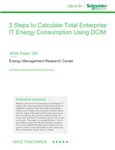2021 was the fifth hottest year on record. Wildfires burned 7.7 million U.S. acres, 2.6 million in our company’s headquarters state of California alone. Climate change demands attention and action from all of us.
Because data centers sit at the nexus of two of the biggest drivers of carbon emissions – energy production and construction – it is important to examine what we can do to lessen the impact. Of these, energy production is by far the biggest challenge for data centers. Estimates vary, but evidence suggests that data centers consume more than two percent of global electricity, and a similar share of carbon emissions. For example, a conventionally powered 10 MW data center is responsible for nearly 90,000 metric tons of CO2 annually at full operation. We cannot ignore captured carbon from construction itself either.
According to the Global Alliance for Buildings and Constructions, building materials and construction make up 10 percent of CO2 emissions. Demand continues to drive greater use of digital infrastructure, so it will continue to expand.
Commitments keep coming
More industry leaders continue to make and commit to progress with their data centers. Facebook, Google, and Microsoft are all high profile examples, and their commitments are worth investigating. Their efforts to drive energy efficiency, source low/zero-carbon energy and reduce waste and water usage are a testament what is possible and how far we must go.
There are still huge opportunities. Five high impact actions that exist for data center operators to drive sustainability include:
- Ensuring that all data centers are – or soon will be – powered by renewable energy. On-site renewable energy production, primarily solar and wind, is both feasible and desirable at many data center sites to decrease carbon impacts, electricity costs and the burden on local power grids. As on-site production usually only covers a portion of the energy needed to power a site, utilizing renewable energy Power Purchase Agreements (PPAs) can also be effective. PPAs also have the added benefit of helping finance renewable energy infrastructure in general.
- Increasing efficiency will go a long way to mitigating the amount of energy needed by energy-hogging data centers. According to reports, around 40 percent of a data center's energy consumption goes into powering its cooling and ventilation systems. As server densities increase, the challenges and costs of existing air-cooling solutions are only going to increase. Research shows that the amount of power needed to cool data centers can be reduced significantly by simply moving to water-cooling servers. Even more impressive are the latest phase change systems that have been shown to achieve a constant PUE of 1.02 (vs. 1.5 or higher for air-cooling), the lowest of any system in the world. Utilizing liquid cooling technologies in new data center builds, or in retrofits of existing facilities, can dramatically reduce energy consumption.
- Examining utilization rates is also key. Alongside cooling, another perennial headache for operators outside of the hyperscale market is utilization. According to one report, nearly 60 percent of the servers surveyed were either ‘zombies’ or idle. Resting servers use between 50 and 70 percent of peak power, which means that 30-40 percent of the electricity for servers is going to power machines that are literally doing nothing. There is no one answer to this issue – it will take a coordinated effort to solve the problem. From the operator side, actions range from identifying zombie servers and notifying users so they can be killed, to helping users better match resources to needs, to structuring hosting contracts so that they reduce the amount of dedicated (read: idle) resources required. All of these actions are simple but have an enormous potential impact.
- Shifting to modular construction for new builds can dramatically reduce construction waste, which is responsible for roughly 40 percent of landfill waste, according to the US Environmental Protection Agency (EPA). With new commercial construction generating around 3.9 pounds of waste per square foot, modular construction can reduce that waste by up to 90 percent, thanks to its off-site construction approach.
- Focusing on the sourcing of “healthier” materials may be the last and least obvious, but only because its impact is hidden from view. Scope 3 Emissions related to materials used in the construction of data centers can add substantially to the lifetime carbon impact of those facilities. Sourcing manufactured items like turbines, compressors and transformers from vendors prioritizing low-carbon production can have a significant effect on sustainability.
More actions
In addition to these steps, there are actions we can take as an industry to help drive sustainability across the board:
- Reinvigorate industry groups and initiatives like the Green Grid and the Climate Neutral Data Centre Pact to drive development of the next generation of sustainability standards and practices across the data center industry.
- Track and manage sustainability impacts using tools such as the Embodied Carbon in Construction Calculator (EC3), the Smart Water Navigator and Microsoft’s Cloud for Sustainability. That said, we need to push to ensure that more and better tools are created to make managing environmental impact just as important in the future as managing financial impact is today.
Collectively we need to push further. Currently, sustainable building approaches often take a back seat to alternatives that have a lower financial cost, but a higher environmental impact. However, as experience with LEED shows, sustainable approaches can increase financial returns over the life of a building – making sustainability a win/win for developers and the planet. There are strong reasons to believe that the same dynamics will play out in the data center industry over the coming years.
Our role in building of some of the industry’s greenest projects and data centers are only the beginning. We will continue to advocate for sustainability and find innovative ways to be part of the solution. This work is already making a difference, and if we come together to do our part, the impact can be bigger than the problem we are trying to solve.





